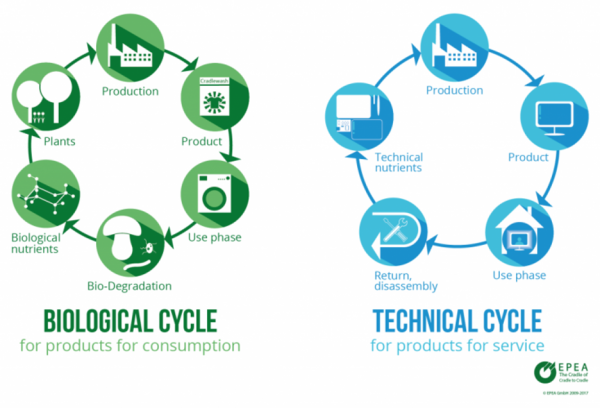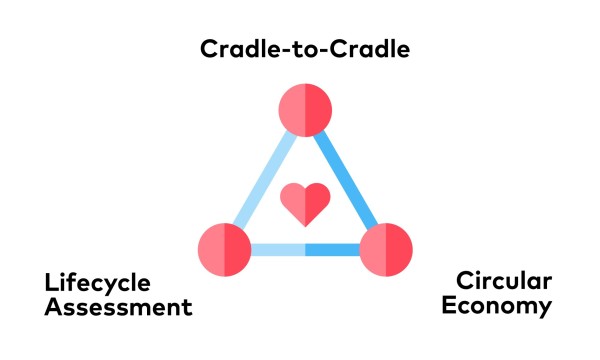Life Cycle Assessment, Circular Economy and Cradle to Cradle are seen as interchangeable terms by some, and totally separate concepts by others. As is the case with most things, the truth lies somewhere in the middle.
A life cycle approach

A life cycle approach looks at all stages in the life cycle of a product
There are similarities between a Life Cycle Assessment (LCA) study, Circular Economy and Cradle to Cradle (C2C), which causes some of the confusion. However, they are different concepts – albeit with a shared approach to sustainability, and problem solving within sustainability.
The common link is a 'life cycle approach' which considers a number of different environmental impacts such as carbon footprint and use of resources. These environmental impacts occur across all stages of a product’s life cycle, from when the raw materials are grown or gathered to where the product ends up after it has been used. The life cycle approach highlights the bigger picture of environmental impact and can act as a great starting point for identifying and improving on environmental hotspots in the manufacturing industry.
Avoid ‘burden shifting’
An LCA study avoids ‘burden shifting’ – solving a problem in one area of environmental impact while creating a problem in another. Take the example of cucumbers. Removing plastic wrap around cucumbers results in lower packaging impacts, but vastly increased food waste downstream. An LCA would look at this information together. It would inform you that wrapping cucumbers in plastic actually results in better outcomes for the climate.
Rethink material use
The C2C concept takes a similar life cycle approach to products but goes one step further to ensure that all materials used in production can be reused as a nutrient. These nutrients stay in either a biological cycle (where they are returned without harm back to the biosphere) or in a technical cycle (where the material is reused continuously without losing its value). In the case of a car tyre, C2C looks not only at what happens to the tyre at the end of its useful life, but also looks at the rubber dust that is left behind from its everyday use on a vehicle. This way, it accounts for the overlooked environmental impact of rubber as it leaves the technical cycle and re-enters the environment.

Image source: EPEA GmbH
An LCA study quantifies environmental impact across a wide range of indicators, but always includes a full carbon footprint. C2C certification requires a carbon programme in place for organisations, but not necessarily a full carbon footprint. Still, these two systems are highly complementary; an LCA study combined with the design principles of C2C opens up data-backed opportunities for a truly circular economy.
The ultimate 'love triangle'
Circular economy also looks at the reuse of materials but with more of a high-level view. It also considers ideas like the sharing economy. These three key players in sustainability combine to form the ultimate 'love triangle'.

Some companies are already putting these ideas to good use
- Levi’s® use LCA studies to identify their environmental hotspots
- Mud Jeans run a ‘Lease A Jeans’ programme to encourage a more circular, shared economy.
C2C-certified jeans will make sure that fibres that are shed in the washing process don’t cause harm as they re-enter the environment from wastewater. The potential is limitless if these concepts and life cycle thinking are fully combined.
Do more good, not just less harm
We already use more resources each year than the earth can regenerate. With an increase in resource use between 1970 and 2019, the Global Footprint Network’s Earth Overshoot Day initiative estimates that as of 2019, we need 1.75 planets to support our current demand on Earth’s ecosystems. Damaging practices don’t become positive just because we do them less; they just serve to delay the inevitable.
This is where C2C stands apart from conventional thinking around sustainability with its focus on optimising positive impact. While an LCA study focuses primarily on reducing negative impact, a product’s sustainable performance can be maximised by bringing together the reliable data of LCA and C2C concepts to inform a wider circular economy.
Use the 'love triangle' to ensure that we don’t simply minimise environmental impact – let’s work to eliminate negative impacts completely and move towards a positive environmental footprint.
By Barbara Nebel, CEO of thinkstep-anz
This article was first published in NZ Manufacturer magazine, March 2020.